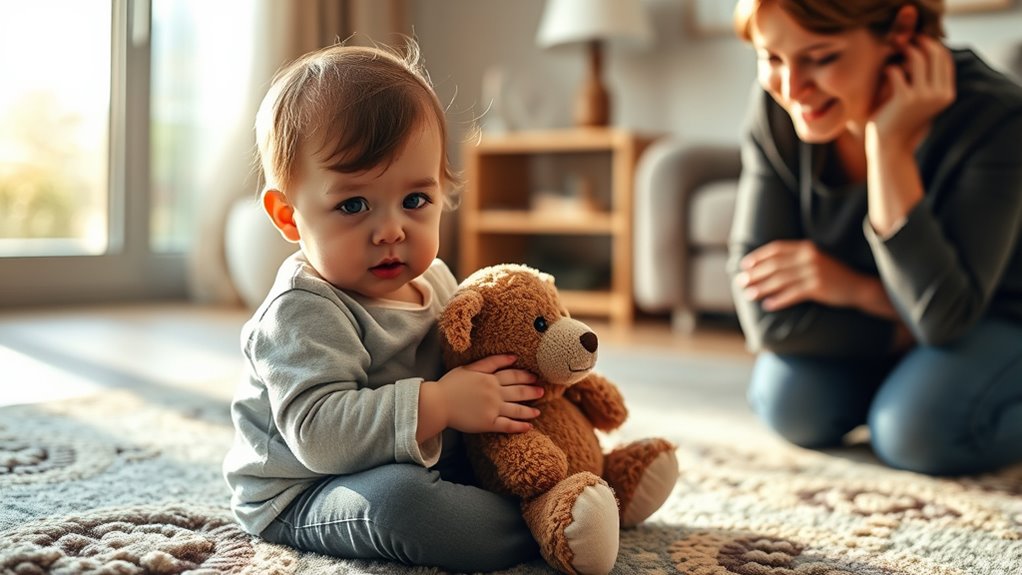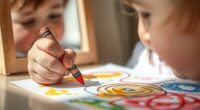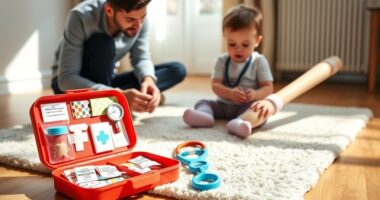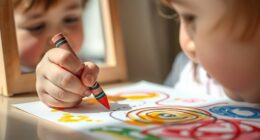Understanding separation anxiety in toddlers is key to helping them feel secure. This common phase shows they’re building strong attachments and gaining independence. Signs like clinginess and distress are normal and indicate healthy emotional growth. To soothe their fears, keep departures brief, stay calm, and offer comfort objects. Be patient as these behaviors lessen over time, and your child’s confidence grows. If you want to learn more strategies, you’ll find helpful tips ahead.
Key Takeaways
- Separation anxiety is a normal developmental phase where toddlers seek security and may show clinginess or distress during separations.
- Recognizing these behaviors as temporary and part of growth helps parents respond with patience and understanding.
- Establishing consistent routines, saying goodbye calmly, and offering comfort objects ease the child’s fears.
- Gradually increasing time apart and celebrating milestones build the child’s confidence and independence.
- Supporting attachment development fosters trust, emotional resilience, and smoother transitions as children grow.

Separation anxiety in toddlers is a common developmental stage that can be challenging for both children and parents. During this time, you might notice your little one becoming clingy or upset when you’re out of sight. These attachment behaviors are a normal part of your child’s growth, signaling that they’re forming strong bonds with you. As they reach certain developmental milestones, such as increased independence or language skills, their awareness of being separated grows, often triggering feelings of fear or distress. Understanding that this phase is temporary can help you respond with patience and reassurance.
Your toddler’s attachment behaviors stem from their natural need for security and comfort. When you leave, they might cry, cling, or search for you around the house. These responses aren’t signs of bad behavior but are instead reflections of their developing understanding of the world. They’re learning to differentiate between familiar and unfamiliar people and environments, which is why they might become overwhelmed when you’re not nearby. Recognizing these behaviors as part of their developmental milestones can help you approach the situation with empathy. It’s important to remember that this phase usually peaks around ages 12 to 18 months but gradually diminishes as your child gains confidence and trust in their environment.
Toddlers seek security, crying or searching when you leave, reflecting their developing understanding and trust.
To soothe your toddler’s fears, you can implement simple, consistent routines that foster a sense of security. For example, saying goodbye in a calm, reassuring manner, and establishing a predictable departure and reunion routine can ease anxiety. Providing comfort objects like a favorite blanket or stuffed animal can also serve as a source of familiarity. When you’re preparing to leave, try to keep your goodbyes brief and positive, avoiding drawn-out farewells that might increase their distress. Reassure them with your tone and words, letting them know you’ll return soon. Over time, as your child becomes more accustomed to separations, these behaviors should lessen.
Supporting your toddler through separation anxiety involves patience and understanding. Celebrate their small milestones of independence, like playing alone for a few minutes or exploring new environments with confidence. Additionally, on-device AI capabilities such as real-time language translation can help you communicate more effectively as your child’s language skills develop, easing their fears and improving your interactions. Remember, this developmental phase is a sign that they’re building the emotional skills needed to navigate the world. Your consistent presence, gentle reassurance, and supportive routines help them feel safe, making it easier for them to overcome their fears. As they grow older, they’ll develop a stronger sense of trust and security, easing the separation anxiety and allowing both of you to enjoy this exciting stage of growth together.
Frequently Asked Questions
How Long Does Separation Anxiety Typically Last in Toddlers?
Separation anxiety in toddlers usually peaks around 14 to 18 months and gradually decreases as they reach key pediatric milestones. During this period, their emotional development strengthens, helping them become more confident and independent. You’ll notice the anxiety lasting a few months for most children, but it varies. With consistent reassurance and routines, you can help your toddler feel secure and support their emotional growth as they navigate this normal stage.
Are There Specific Triggers That Worsen Separation Anxiety?
Think of separation triggers as storm clouds gathering over your toddler’s sunny day—sudden changes like unfamiliar people or loud environments can intensify their fear factors. These separation triggers often include unfamiliar settings, loud noises, or routine changes, which heighten their anxiety. Recognizing these fear factors helps you prepare and soothe your child, making passages smoother and easing their distress during times of separation.
Can Separation Anxiety Indicate Underlying Developmental Issues?
Separation anxiety can sometimes signal underlying developmental issues, especially if attachment styles are insecure or inconsistent. As a parent, you should observe your toddler’s reactions and consider whether their fears are extreme or persistent. Using effective parental strategies, like consistent routines and reassuring presence, can help. If concerns persist, consulting a specialist can help determine if there’s an underlying developmental concern needing further support.
What Are Early Signs of Separation Anxiety in Infants?
Imagine a tiny boat tugged by a fragile string—that’s how early signs of separation anxiety in infants feel. You might notice clinginess, crying when you leave, or heightened attachment behaviors. These signals show your baby seeks comfort through bonding activities, reinforcing their attachment. Recognizing these cues early helps you reassure your infant, strengthening your bond and easing their fears as they learn to trust that you’re always nearby.
How Can Siblings Help Ease a Child’s Separation Anxiety?
You can help ease your child’s separation anxiety by encouraging sibling bonding and role modeling. Have siblings spend quality time together, showing support and reassurance. When older siblings display calmness and confidence during separations, they serve as role models, helping your anxious child feel more secure. This positive interaction fosters trust, reduces fears, and gradually builds your child’s confidence in being apart from you.
Conclusion
Remember, separation anxiety is a normal part of your toddler’s development. While it may be tough to see them upset, your consistent reassurance and patience help them build confidence and trust. If you’re worried about making things worse, keep in mind that gentle, loving responses actually ease their fears faster than rushing to comfort. With time and understanding, you’ll both navigate this stage smoothly, strengthening your bond and helping your little one feel secure even when you’re apart.









